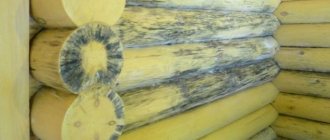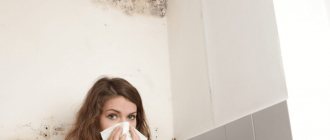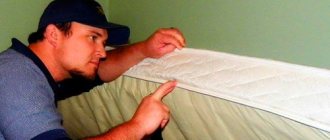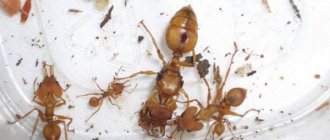Ceramic tiles on walls and floors are not only beautiful, but also practical. Durable tiles are easy to clean and retain their appearance for many years. However, this type of cladding has one drawback: over time, the tile seams become dirty, and sometimes, due to high humidity, they become covered with mold and mildew. This article will discuss how to clean mold from seams in the bathroom using household chemicals and folk remedies.
Why does fungus and mold appear?
Causes of mold and mildew:
- High humidity.
- Lack of natural sunlight.
- Lack of ventilation or poor quality of ventilation.
- No treatment with special compounds.
Fungus not only spoils the appearance of the room, but also harms human health.
When mold appears, you must immediately clean the surface, but do not forget to follow safety rules. Stock up on the following items:
- latex gloves;
- application brush;
- dilution container;
- protective glasses;
- spray.
Advice. It is best to carry out seam cleaning work when there are no children or animals nearby in order to avoid unforeseen situations.
How to recognize mold on tile seams
Every second housewife asks this question. The fungus is a plaque of gray, black and blue color. By touching the places where moldy spots appear, you can feel their softness (it is necessary to touch mold only with rubber gloves). This way you can recognize the fungus by its appearance.
There are other ways to find out that an “unpleasant neighbor” has moved into an apartment. One of them is smell. When fungus appears in the bathroom, a musty and damp smell appears. It feels like you are in a basement. As soon as an unpleasant odor appears, you should carefully inspect the seams between the tiles for the presence of fungal formations.
Professional mold removal
Moscow +7 (916) 356 2690;
St. Petersburg (921) 940 5760
Important! Mold-affected areas of bathroom surfaces can cause constant headaches for all residents of a given living space.
We clean mold on cement grout and sealant (silicone, acrylic) with folk remedies.
The only way to clean the sealant from fungi and mold is to completely replace it. To do this, open the seams, removing the silicone sealant, treat and dry the surface until completely dry, and only after that the seams are sealed with new sealant.
However, it is not always possible to make such a radical solution to the problem. Then the old, time-tested methods are used. Here are some of them:
The most radical method of removing fungus is to open the seams and replace the grout
Regular white vinegar can kill up to 80% of mold species. In addition, this tool is almost always at hand. In order to remove mold and mildew, you need to soak a cloth in a vinegar solution or pour it into a spray bottle and apply it to the affected areas of the seams. Leave the tiles until the vinegar dries, then clean the seams with a stiff brush and rinse with water.
Hydrogen peroxide works well on small mold colonies. It cleans both silicone and cement joints. The procedure for working with hydrogen peroxide is no different from cleaning with a vinegar solution: apply, let dry, rub with a brush and rinse with water.
Attention. Don’t forget about the slight whitening effect of peroxide, so you should use it carefully near dark plastic.
Tea tree oil can also help cope with a difficult situation. To do this, you need to dilute one teaspoon of oil in a glass of warm water and spray the resulting solution onto the tiles. There is no need to wash off this solution, but it is better to apply it at night, when no one will be visiting the bathroom.
Liquid compositions are very convenient to apply to the wall using a spray bottle.
Another effective method is a solution for which you need to mix 2 tablespoons of hydrogen peroxide, 1 tablespoon of boric acid, 4 tablespoons of water and 2 tablespoons of table vinegar. It is necessary to wipe the affected seams with the solution.
Soda and vinegar . This method is only suitable for horizontal surfaces. It is necessary to pour a sufficient amount of soda onto the contaminated seams, then pour in table vinegar. When the foam disappears, wash the areas well with soapy water.
Furacilin can also save you from fungus in the bathroom. One tablet of furatsilin must be diluted in a liter of water and treated with the surface of the seams. Some claim that after such treatment they did not encounter any fungus in their bathroom.
After the product has been left on the surface for 15-20 minutes, wipe the seams with a sponge.
The most effective ways to combat mold
Removing mold between tiles can be done in several ways:
- mechanically;
- using chemicals;
- using folk remedies.
Mechanical methods of combating mold fungi
Mechanical methods are effective only at the early stage of infection.
With their help, you can remove mold from tile seams if the fungus has not managed to penetrate into the deep layers of grout and under the tile itself.
At the initial stage, you can use fine-grained sandpaper. It is used to carefully rub the seams between the tiles, being careful not to touch the tile itself.
Trying to remove mold with a rough brush
When the cleaning work is completed, dirt and mold residues in the bathroom between the tiles are washed off with water, and then the surfaces are thoroughly dried.
If this method turns out to be ineffective, you can try deep cleaning by completely removing the grout.
Removing grout from tiles
This work is carried out using a screwdriver or other sharp object. You need to scrape out the grout very carefully, being careful not to touch the edges of the tiles.
When the grout is completely removed, the cleaned surfaces are treated with an antifungal compound and filled with silicone sealant.
Application of silicone sealant
Mold does not form on silicone, so this material will serve as an excellent preventive measure.
Fighting mold with chemicals
When thinking about how to remove mold in the bathroom between the tiles, you should pay attention to household chemicals. Its use will allow you to remove microorganisms from the room faster and more reliably.
Example of personal protective equipment
But since any chemicals are toxic, treatment must be carried out using personal protective equipment (rubber gloves, respirator).
There are several effective anti-mold remedies.
Household chemicals containing chlorine. Whiteness is the most accessible chlorine-containing product.
Product Whiteness
You can also purchase more aggressive products, for example, Domestos or Cillit. They are used undiluted, applied to the affected surfaces with a sponge, left for 40 minutes and washed off with water.
Antiseptics. These include Antifungal, Izocid, Polymix, DALI, and HD products. These medications must be used strictly following the instructions for use.
Fighting mold with folk remedies
How to remove mold in the bathroom between the tiles without resorting to the use of aggressive chemicals? You can turn to the help of improvised means that can be found in every home.
Baking soda
Baking soda helps remove mold from tile joints without giving it a chance to grow further.
For these purposes, soda powder is diluted with water to a pasty state.
Baking soda
The paste is applied to the seams using an old toothbrush. After an hour, the treated surfaces are washed with water and dried.
Table vinegar
Molds are not able to live in an acidic environment. Vinegar is a killer for them. Armed with a sponge dipped in vinegar, treat the affected surfaces.
Table vinegar
After an hour, the product is washed off with water and the room is ventilated.
Vinegar is an excellent preventative. To prevent the formation of mold in the future, this treatment is carried out twice a month.
Hydrogen peroxide
This drug is essentially active oxygen, which has a detrimental effect on any pathogenic microorganisms.
Hydrogen peroxide for cleaning mold
To clean mold in the bathroom between the tiles, use a sponge soaked in hydrogen peroxide.
After the surfaces are completely dry, you need to take a stiff brush and thoroughly clean the walls from dark spots.
Boric acid
This powder is popularly called borax. To prepare an effective remedy against mold fungi, prepare a mixture.
It consists of the following components:
Boric acid is poorly soluble in cold water. Therefore, first you need to dilute it in a small amount of boiling water, add the remaining ingredients, and mix thoroughly.
Boric acid
All affected surfaces are treated with the resulting mixture.
Ammonia solution
To clean mold between the tiles, use 1 teaspoon of ammonia and 20 drops of tea tree oil, which are diluted in 2 glasses of water.
The resulting solution is used to treat the seams.
Ammonia solution
After 30 minutes it is washed off with water.
What danger does mold pose to humans?
The proliferation of mold fungi contributes to the formation of dark spots.
Their appearance is reflected in the appearance of the room. The bathroom has a musty smell and a damp feeling.
When even small dark spots appear, you must immediately think about how to remove mold from the tile joints before it causes their destruction.
Not only the affected surfaces are subject to destruction, but also the residents of the apartment.
Molds reproduce through spores floating in the air. Once in the human lungs, they cause the development of bronchial asthma and other allergic diseases.
Mold close up
The fungus is especially dangerous for weakened people, including children, the elderly, and pregnant women.
Hovering in the air, fungal spores settle on human food and clothing, bedding and other surfaces.
People living in contaminated premises are attacked daily by millions of pathogenic microorganisms.
Signs of attacks are weakness and a feeling of weakness. Mold fungi contribute to a deterioration in overall health and exacerbation of chronic diseases.
You can also read our article: Why mold in an apartment is dangerous for human health
Conclusion
Once the tile seams have been treated from mold, you should not relax. If the reasons for its appearance are not eliminated, it will return again.
To ensure good ventilation, it is necessary to install a hood in the bathroom or use forced ventilation methods (open door).
It is necessary to eliminate all leaks, and replace cast iron pipes with plastic ones, which will avoid the formation of condensation.
Mold on cement grout and sealant (silicone, acrylic) is cleaned with household chemicals
If you do not have allergic reactions to household chemicals and all kinds of antiseptic drugs, and folk remedies are not to your liking, then you can resort to specialized chemicals to fight the fungus. Here are some of them:
- Chlorine-containing household cleaners. The most popular of these is household bleach, which is mixed with water and applied to the grout. After 15–20 minutes, wipe the seams with clean water.
- An antiseptic called “Antifungal” can be used both for repairs and for eliminating existing mold. The solution can be applied to any surface, including seams, silicone or cement grout - it doesn’t matter. This type of antiseptic is non-toxic and is considered completely safe.
- "Isocide" represents a whole series of anti-fungal and anti-mold preparations, suitable for all surfaces and protecting against the reappearance of fungi.
Read on the antiseptic packaging: substances can be washed off or do not require post-processing - MIL KILL latex emulsion contains special substances that prevent the development of mold and is very effective in places with high humidity. It is completely harmless to people and therefore can be safely used to clean grout lines in the bathroom and kitchen.
- "DALI" is a universal antiseptic that effectively destroys foci of fungus. It, like the drugs described above, is not dangerous for people and animals and can be used to destroy mold on seams in residential premises.
- When working with a specialized HG for removing fungus and mold, it is advisable to ensure a flow of fresh air into the room, because the antiseptic has a fairly strong specific odor. After spraying, leave the product for a few minutes, then rub particularly dirty areas with a brush, if necessary. The product is washed off with warm water.
Attention. “Whiteness” and its analogues are a rather aggressive agent, therefore, when using this product, be sure to use gloves, and also take care to protect your eyes and respiratory tract.
Why does mold form?
To understand how to remove mold in tile joints, you need to understand the reasons for its appearance. No special conditions are required for the fungus to multiply.
Traces of mold in the bathroom
It only needs moisture. That is why the ideal place for the formation of mold colonies is the bathroom.
The decisive factors for this phenomenon include:
- poor ventilation, which contributes to the formation of moisture;
- leaking pipes and plumbing;
- drying wet laundry;
- cast iron pipes on which condensation forms;
- poor location of the bathroom, which contributes to the formation of excessive dampness;
- poor quality waterproofing of surfaces;
- lack of natural light (ultraviolet radiation destroys fungal spores).
In the old days, mold was an infrequent guest in residential buildings. Wooden windows and doors allowed air to circulate, providing good ventilation.
Therefore, people rarely thought about how to remove mold between tiles in the bathroom and other rooms.
The installation of plastic windows and sealed doors increased the sound insulation of the premises, but led to the formation of condensation, which caused extensive growth of fungus.
Sanitation and ionization
In addition to the above methods, there is also a method that uses a stream of air enriched with ions and microelements, which is directed to the problem area. A special device is used for this. In addition, training is required. Most often, this method is chosen when other methods have not helped and the fungus has become firmly entrenched. The disadvantage of ionization is the need to call a specialist and the high price.
Using a Steam Cleaner
Don't forget about the steam cleaner. With this unit you can clean not only the seams between the tiles, but also wash the tiles from plaque.
There are many ways to clean seams. And almost all of them are suitable for any type of seams, both for cement grout and silicone. But whatever method you choose, remember that you must follow safety rules, avoiding contact of products with your eyes and respiratory tract. Carefully read the instructions for the purchased antiseptics and follow the instructions. And so that you don’t have to fight the fungus in the future, try to prevent its appearance. For this, good ventilation and regular cleaning of the room are sufficient.
Why does mold appear in bathroom tile joints?
On various home economics forums, the question often comes up about how to remove fungus from tiles: after all, cleaning is done regularly, and with the use of special detergents. But, alas, the fungus does not disappear from the tiles, even if the joints are cleaned thoroughly.
In order to begin to effectively fight mold in the bathroom, first of all, you need to find out the reasons for its occurrence on the tiles. There may be several of them:
- The appearance of fungus on the tiles and in the seams between them is due to errors during their installation;
- Faulty ventilation system in the bathroom;
- Air temperature is too low;
- Insufficiently thorough cleaning of the premises;
- Problems with excess air humidity;
- Too frequent water treatments, washing and drying clothes.
The first rule for preventing the appearance of mold on tile joints is to ventilate the room after each water procedure. This is very easy to do, you just need to open the door to the bathroom. Or simply install a fan in the vent. This will speed up the removal of excess moisture from the bathroom.
Also, a heated towel rail or heater is great for preventing the appearance of a “bad resident.” This will keep the bathroom warm. And also treat the walls and floor with detergents for cleaning.
Important! The main cause of mold is the accumulation of moisture, so during cleaning you should wipe all treated surfaces dry!
Mold removal: photo
Chemicals against fungus on ceramics in the bathroom
Getting rid of fungus on tiles is facilitated not only by the above remedies, which any caring housewife always has on hand. This can also be done through specialized drugs intended for these purposes.
Treatment with such preparations allows you to completely clean all surfaces in the room, including areas under sanitary and hygienic devices. However, the main task is to eliminate the causes of mold growth.
Before embarking on cleaning activities, you must study and strictly adhere to the rules for pre-treatment of surfaces. First, severe contamination is removed, then the area is dried using a hair dryer. It is not recommended to include water during the treatment procedure, because the air regime must be kept dry. The seams between the tile elements are also thoroughly treated with antifungal agents.
Please note: when working on surface treatment with special chemicals, always follow personal safety rules. The face is covered with a protective mask, hands with rubber gloves. This is the only way to avoid harm from the use of active chemical compounds, contact with which in a closed space can hardly be avoided.
A solution of copper sulfate is used to remove mold in the toilet and bathroom directly from the tiles and from the seams. The toxicity of vitriol should be a warning to take safety precautions. The instructions for use state that the product is mixed with water in a ratio of 100 to 10, that is, 100 g of the substance is added to 10 liters of water. The tiled surface is treated with a solution in which a sponge is soaked. Vitriol is applied to the seams with a toothbrush or brush. In places where there is a strong accumulation of blackness, the product is passed over repeatedly. Then wait several hours and wash the base. The air in the room is ventilated.
Chlorine bleach is also an excellent mold remover. The substance does not require rinsing. After the procedure, the space is ventilated.
List of industrially produced anti-mold preparations:
- Renogal;
- PS 50;
- Titan Fungcide;
- impregnation "Snowball";
- Spectrum.
Many people neglect to purchase these specialized antifungal drugs, preferring more budget-friendly options (for example, copper sulfate). However, excessive enthusiasm for the latter can be costly for the homeowner. Since the use of copper sulfate, getting rid of one type of fungus, can cause the development of another. In this connection, the most preferable option is to choose a modern industrial product.
You can eliminate mold on bathroom tiles by treating it with furatsilin. This remedy has proven itself on the positive side in the fight against blackness. Why apply furatsilin solution - 1 tablet per liter of water. Moreover, the drug is inexpensive and quite effective. Many who used it claimed that they forgot for a long time what a fungal infection on the walls was.
Please note: it is possible to spray an antiseptic only when there are no children, adult relatives or pets living in the house. When mold appears in sanitary facilities, it is important not only to take measures to eliminate it, but to minimize all further possibilities for its appearance. A fairly common cause of a humid climate in the bathroom is pipes covered with condensation, leaking taps, damage to the waterproofing of drains or water pipes and other malfunctions with plumbing fixtures.
Professional products will help solve the problem of blackness on ceramic coatings. Their packaging should clearly state that they kill mold and are not preventatives. The decision about whether to use such means, or whether to use popular advice, must be made by everyone, taking into account the specific situation.
Mold prevention
It is quite possible to remove mold and mildew from food with diligence and some time.
It is much more important to prevent their reappearance. To do this, you need to take into account simple advice from experts. Do not leave damp or wet clothes in the bathroom; dry them outside. Provide the room with constant air circulation, maybe even artificially. Finally, fix the emergency plumbing and seal the interpanel seams of the room.
After taking a relaxing bath or extensive laundry, wipe all surfaces dry with antiseptic. Follow these simple tips and your bathroom will always be an oasis of cleanliness and freshness.
Popular means
When faced with the appearance of fungus in the bathroom, most people are not even aware of the seriousness of the problem. Only special antiseptics can be used here. You can buy them at any hardware store. The drugs will help not only cope with the fungus, but also prevent its reappearance. Effective household chemicals include:
- Metas - BIO. It will quickly get rid of the fungus that has already formed growths on the bathroom wall.
- NANO-FIX. Eliminates all stains that indicate the presence of fungus.
- NEOMID Bio. It is recommended to treat walls prone to fungus formation with these preparations to prevent its occurrence. Helps cope with the problem in the early stages.
- Dali. The product is universal and suitable for use on any surface.
- Biotol. It is a popular remedy in the fight against fungus on bathroom walls. It is chosen due to its convenient packaging. The product is available in the form of a spray, which is very convenient for treating contaminated surfaces.
To eliminate fungus from bathroom walls, you can use not only antiseptics, but also simple bleaches.
They contain sodium hypochlorite, which will help quickly rid the apartment of the formed columns of spores. Bleach cannot be used on all surfaces, but only on glass, tiles, bathtubs and other non-porous materials.
Traditional methods
In addition to official fungicides, folk ways to solve the problem are also largely effective. This method is especially suitable for those who, for one reason or another, cannot tolerate the use of chemicals.
For example, tea tree oil is an excellent option offered by the people. It is mixed with warm water. Treatment is carried out using a sprayer. The composition does not need to be washed off.
The composition of boric acid, iodine and tea tree oil has proven itself well. In addition, to treat surfaces, they use such improvised means as borax (dissolve a glass of powder in 1 liter of water), ammonia (the proportions with water are 1 to 1).
However, the use of traditional methods of struggle is only suitable when the blackness has just begun to manifest itself on the tiled surface. If the fungus is a habitual inhabitant here, then it is better to resort to professional means, or even better, to the help of specialists.
Household chemicals
Designed to quickly and effectively remove fungus, household chemicals can clean contaminated surfaces several times faster than any folk remedy.
"Belizna" - chlorine-based solution
The most famous and inexpensive product called “Whiteness” for 50 rubles.
Excellent removes mold stains from various surfaces. Spraying a bleach solution onto a whitewashed ceiling will remove mold stains and stop mold growth.
To prepare the solution:
- Bleach is diluted with water in a ratio of 1 to 10.
- Apply it to a cleaned surface and wait for it to dry.
The disadvantage of this product is the specific smell of chlorine.
Oxygen bleach
It is based on sodium percarbonate , which can cope with different types of mold.
There is a large selection of such bleaches on sale. The most famous:
- "Bos Plus" costs about 30 rubles;
- “Sano Oxygen”, it can be bought for 280-300 rubles;
- “Vanish Gold” for 140-150 rubles.
Special antifungal
Such products are distinguished by their speed of action and effectiveness . With its help you can easily tidy up:
tiles;- plumbing;
- shower cabin.
Cleaning surfaces will take from 10 minutes to an hour . The most popular products today are:
- “Cillit Bang”, price 150-170 rubles;
- spray “Unicum”, costing about 180 rubles;
- “Turbo”, priced at 300-350 rubles.











